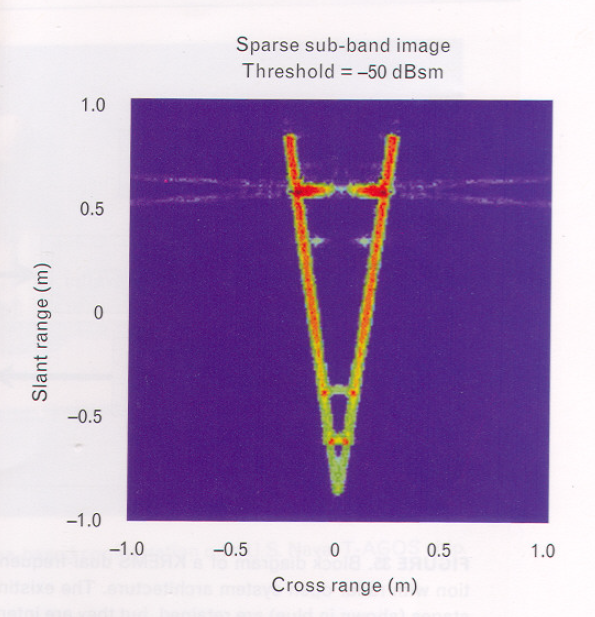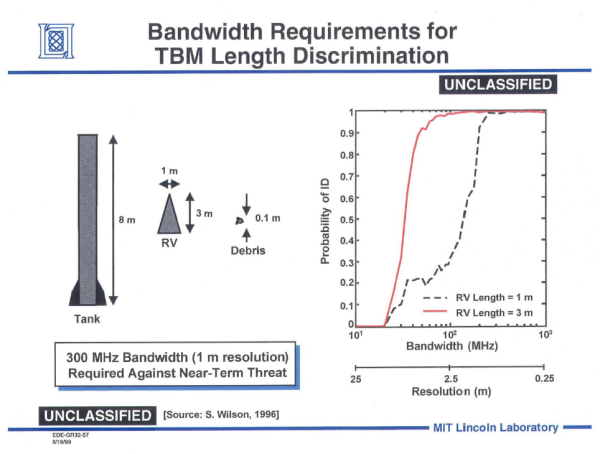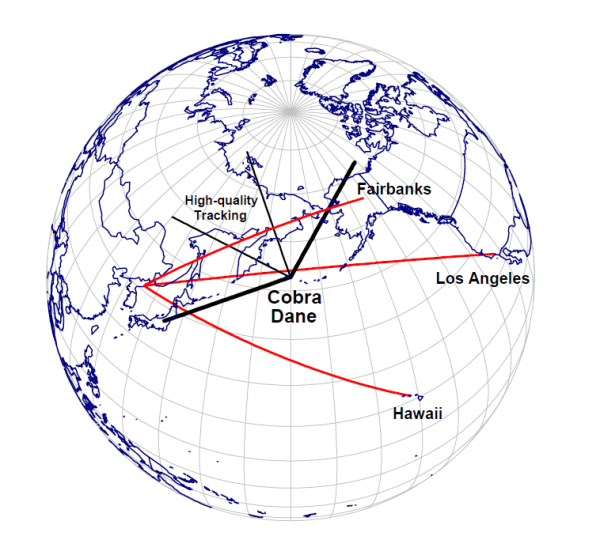My previous missile defense post (August 24) compared the three-phase national missile defense (NMD) system plan developed by the Ballistic Missile Defense Organization (BMDO) during the Clinton Administration with the current GMD system. One of the most striking differences in this comparison was the lack of long-range radar discrimination in the current GMD system. While the BMDO plan would have ultimately deployed eight or nine very large X-band Ground-Based Radars (GBRs), the current GMD has only one such radar, the Sea-Based X-band (SBX) radar. Moreover, the SBX, which is somewhat smaller than the GBRs envisioned under the BMDO plan, is scheduled to be semi-mothballed in FY 2013 by cutting its budget by more than 90% and putting it in a “limited test and operations” status.
This post explains why the absence of these large X-band GBR radars leaves the current GMD vulnerable to defeat by the simplest of countermeasures, even unintentional ones. The fundamental problem is that the core radar infrastructure of the GMD consists of Upgraded Early Warning Radars, which have essentially no discrimination capability.
Figure 1. Simulated two-dimensional image of a warhead by a radar with a bandwidth of about 6 GHz, corresponding to a range resolution of about 5 cm.[1]
The Role of the Upgraded Early Warning Radars
In both the initial BMDO C-1 NMD system, which could have been deployed by 2005-2007 had a decision to deploy been made in 2000-2001, and the current GMD system, basic detection and tracking of incoming warheads would be accomplished using existing Early Warning Radars. These radars are located at Beale Air Force Base in California, on Cape Cod in Massachusetts, at Clear in central Alaska, at Thule in Greenland, and at Fylingdales in Great Britain. These radars would have received relatively minor upgrades (and thereafter be called Upgraded Early Warning Radars (UEWRs) that would have enabled them to track an incoming missile target accurately enough to guide interceptors. Under the BMDO plan, all five existing early warning radars would have been upgraded by 2005-2007. As part of the current GMD system, three of the radars (California, Britain and Greenland) have been upgraded, with the other two currently scheduled to be upgraded in 2016-2017.
The UEWRs are large, powerful radars, capable of detecting and tracking warhead-sized targets at ranges of several thousand kilometers. In the BMDO NMD system, once these radars (assisted by data from early warning satellites) have detected and begun to track incoming targets, this tracking information would be passed on to co-located GBRs, which could then acquire the targets and attempt to discriminate real warheads from debris or decoys and other countermeasures. Because of the very narrow radar beam widths of the GBRs (and the reduced radar cross sections at their higher operating frequency) their ability to search for targets whose position is only approximately known is less than that of the UEWRs. However, the range resolution of the GBRs is much better than of the UEWRs, making the discrimination of warhead from other objects at least potentially possible.
Why the Upgraded Early Warning Radars Can’t Discriminate
The resolution of a radar is the minimum separation between two objects for which the radar can determine that there are two objects present rather than just one. Thus if two objects are separated by 5 meters in range, a radar with a range resolution of one meter would not only be able to identify that there were two objects present (assuming there is adequate signal-to-noise), but also be able to measure the difference in range between the two objects and to estimate the radar cross section of each object. On the other hand, if the radar range resolution was 20 meters, it would see the two objects as a single target.
For a given target, if the range resolution of the radar is significantly less than the length of the target, then it can attempt measure the length of the target (length here means the dimension of the target along the range axis). This information could be used, for example, to distinguish between a 2 meter long warhead and an eight meter long rocket booster stage, as shown in Figure 2 below. If the range resolution of the radar is small enough, it could potentially measure the position and radar cross section of radar scatterers along the length of the target, thus creating a range profile of the target that might be further useful in identifying it.
Radars measure the position of objects in both range and angle (cross-range). While the angular resolution of missile defense radars is typically far too poor to separate objects in the cross-range directions unless they are 100s of meters or even many kilometers apart, their range resolution can be a fraction of a meter. The range resolution of a radar is largely determined by its bandwidth, the extent of frequencies over which a radar can operate in a single measurement. The theoretical minimum range resolution a radar can achieve is given by:
∆R = c/(2β), where c is the speed of light β is the bandwidth (in Hz). This can be rewritten as:
∆R = (0.15 m)/βG, where βG is the bandwidth in GHz (1×109 Hz).
For a phased-array radar (as all modern U.S. missile defense radars are), it is difficult to implement a bandwidth much greater than about 10% of the radar’s operating frequency. For example, the current generation of U.S. X-band radars operate at a center frequency of about 10 GHz and reportedly have a bandwidth of 1 GHz.[2] According to the above formula, this bandwidth would then give a minimum range resolution of ∆R = 0.15 m = 15 cm. In practice, the actual minimum resolution is often somewhat greater: the U.S. X-band missile defense radars reportedly have a range resolution of about 25 cm.[3]
Radars that can operate with large bandwidths (several hundreds of MHz or more) are referred to as wideband radars. Provide that the target they are observing has some rotational motion with respect to the radar, wideband radars can also use Doppler processing to obtain a small resolution in one cross-range direction, enabling the production of two-dimensional radar images, as shown in Figure 1 above, that are potentially useful for discrimination.
However, the Upgraded Early Warning Radars at the core the U.S. GMD system, which operate at a frequency of about 0.44 GHz, have maximum bandwidths of about 10 MHz (0.001 to 0.01 GHz), corresponding to a range resolution of about 15 m.[4] Thus these radars are completely unable to use length measurements to distinguish a warhead from a piece of debris or a rocket booster stage, much less from an intentional decoy.
This point is clearly made by figure 2 below, taken from a Lincoln Laboratory briefing. It shows that a radar with the bandwidth of the X-Band radars (1 GHz = 103 MHz) EWRs can easily distinguish between a warhead and a booster stage or a piece of debris by measuring their lengths (assuming there is adequate signal-to-noise to do so). On the other hand, the Upgraded Early Warning Radars (bandwidth = 10 MHz = 101 MHz) have no capability to so at all.
Figure 2. Bandwidth required to distinguish a warhead from a booster stage or debris[5]
A 2004 Government Accountability Office report makes the same point (at the time of this report, only the Early Warning Radar located at Beale Air Force Base in California had been upgraded):
“Neither the Cobra Dane radar nor the upgraded early warning radar at Beale is capable of performing rigorous discrimination, a function achievable only by the X-band radar. Rather, both radars will utilize common “target classification” software that enables them to classify targets as either threatening or non-threatening. For example, debris would be classified as non-threatening, but objects like deployment buses and decoy replicas would be classified as threatening. Accordingly, the system would have to rely solely on the kill vehicle for final target selection.”[6]
While this statement implies that UEWRs might be able to discriminate some debris based on their relatively small radar cross sections, such an approach would be extremely risky due to the possibility of the attacker reducing the radar cross section of the warhead by using radar absorbing materials.
Why the Other Radars in the GMD Cannot Compensate for the UEWR’s Inability to Discriminate.
In addition to the three (and likely eventually five) UEWRs, the current GMD system includes other radars with greater intrinsic discrimination capabilities, specifically the Sea-Based X-band (SBX) radar, the Cobra Dane radar, and forward-based TPY-2 and Aegis radars. However, none of these radars can compensate for the GMD system’s lack of the large X-Band GBR radars.
The SBX is large and powerful radar, and although somewhat smaller than the never-built land-based GBRs (the SBX has less than 80% of the range of a GBR), it has the same range resolution. However, it suffers from several serious limitations. First, and most importantly, there is only one SBX and no plans to build another. For comparison, the BMDO’s proposed NMD system would have included 8 or 9 GBRs. Second, the SBX was built for testing purposes and as a result does not have some features that would be desirable in an operational system, such as the hardening against electromagnetic pulse effects and redundant electronics that the GBRs would have had. Finally, to save money (the SBX costs at least $160 million a year to operate) the SBX is being essentially mothballed by placing in it a limited test and operations status and reducing its budget by more than 90%.
The Cobra Dane radar on Shemya Island in the western Aleutian (the proposed site for the first GBR) is also a large and powerful radar. However its location and orientation are poorly suited for operating as a part of the GMD, as shown in Figure 3 below, and Cobra Dane has never participated in a GMD intercept test. Cobra Dane has a bandwidth of 200 MHz, giving a range resolution of about 1.1 m, or more than 4 times poorer than the X-band radars. However, it only has this wideband capability within ±22.5 degrees of its boresite. Outside these angles its range resolution falls to about 30 meters. Thus, as shown in Figure 3, against a missile launched from North Korea, Cobra Dane will only have a potential discrimination capability if the missile is aimed at Alaska, and even then only for a portion of the missile trajectory.
Figure 3. Angular coverage of the Cobra Dane radar on Shemya Island. The figure is from the Technical Realities Report.[7] Also shown are the ground tracks of an ICBM from North Korea to Fairbanks, Los Angeles and Honolulu. Within 22.5º of the radar boresite (the area labeled as “High-quality tracking”) the radar can operate with a bandwidth of 200 MHz and a range resolution of 1.1 m. Outside of this area, the radar’s bandwidth is only 5 MHz, corresponding to a range resolution of at best 30 m. While this figure makes it appear that a small part of the trajectory towards Los Angeles would be in the high-quality tracking zone, in fact this part of the trajectory lies well above this zone.
The GMD also includes smaller, forward deployed radars. These are two TPY-2 X-band radars deployed in Japan and Turkey, and, at any given time, several of the current total of about 23 Navy cruisers and destroyers whose Aegis SPY-1 radars have been upgraded for missile defense purposes are forward deployed. However, these radars have much shorter ranges than the other radars discussed here, and are essentially limited to observing missiles early in their flight (if they are close enough to the launch point) and relaying this information back to the GMD for the other radars to use.
Conclusion
The current GMD national missile defense system has only one very long range radar that can even attempt to perform discrimination, the Sea-Based X-band Radar. However, the SBX is about to be semi-mothballed by placing it in a limited test and operations status and drastically cutting its budget. There are no announced plans to address the serious discrimination deficiencies of the GMD system.
It should be noted that while a radar needs a small range resolution if it is to have a potential discrimination capability, having such a capability does not ensure that discrimination can actually be accomplished. In order for this to occur, the warhead must have observable characteristics that are different than the decoys or other objects. However, there are a number of well-known techniques for obscuring such differences, such as disguising the warhead (so that it looks like debris) or enclosing the warhead in a light-weight balloon and deploying it along with a large number of empty balloons.
[1] The figure is from: Philip A, Ingwersen, William W. Camp, and Alan J. Fenn, “Radar Technology for Ballistic Missile Defense,” Lincoln Laboratory Journal, Vol. 13, No. 1 (2002), pp. 109-145 (p. 144). It shows an image of a model reentry vehicle on a static test range produced using two 1 GHz subbands separated by three GHx.
[2] Ingwersen, et. al., “Radar Technology,” p. 145 These X-band radars include TPY-2 radars used as both forward-based X-band radars (FBXs) and as the radars for the THAAD theater missile defense system, the Sea-based X-band (SBX) radar, and the prototype GBR at Kwajalein Atoll.
[3] Ingwersen, et. al., “Radar Technology,” p. 141.
[4] See the post of April 12, 2012: “Space Surveillance Sensors: The PAVE PAWS and BMEWS Radars.”
[5] Eric D. Evans, “Missile Defense Technology (Can BMD Systems Work?),” Briefing Slides, Mini DTS Course, MIT Lincoln Laboratory, December 10, 1999. (Dr. Evans is currently the Director of the Lincoln Laboratory.)
[6] U.S. General Accounting Office, “Missile Defense: Actions Being Taken To Address Testing Recommendations but Updated Assessment Needed,” GAO-04-254, February 2004, p. 17.
[7] Lisbeth Gronlund, David C. Wright, George N. Lewis and Philip E. Coyle III, Technical Realities: An Analysis of the 2004 Deployment of a U.S. National Missile Defense System Cambridge, Mass.: Union of Concerned Scientists, 2004), p. 37. Available at: www.ucsusa.org/assets/documents/nwgs/technicalrealities_fullreport.pdf.


